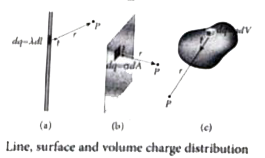How do we determine the electric field due to a continuous charge distribution ? Explain. Electric field due to continous charge distribution Solution in Tamil
The electric charge is quantized microscopically। The expressions of Coulomb.s Law, superposition principle force and electric field are applicable to only point charges। While dealing with the electric field due to a charged sphere or a charged wire etc।, it is very difficult to look at individual charges in these charged bodies। Therefore, it is assumed that charge is distributed continuously on the charged bodies and the discrete nature of charges is not considered here। The electric field due to such continuous charge distributions is found by invoking the method of calculus।
Consider the following charged object of irregular shape।The entire charged object is divided into a large number of charge elements △q1,△q2,△q3................△qn
 and each charge element Aq is taken as a point charge
and each charge element Aq is taken as a point charge
The electric field at a point P due to a charged object is approximately Here △ qi is the ith charge element, i।th, is the distance of the point P from the i." charge clement and ˆr is the unit vector from ith charge element to the point P।
However the equation is only an approximation। To incorporate the continuous distribution of charge, we take the limit △q→0(=dq)। In this limit, the summation in the equation becomes an integration and takes the following form
→E=14πε0∫dqr2ˆr

Here r is the distance of the point P from the infinitesimal charge dy and r is the unit vector from dq to point P। Even though the electric field for a continuous charge distribution is difficult to evaluate, the force experienced by some test charge q in this electric field is still given by →F=q→E।
(a) Line charge distribution: If the charge Q is uniformly distributed along the wire of length L, then linear charge density (charge per unit length) is 2 = । Its unit is coulomb per meter (Cm−1)। The charge present in the infinitesimal length dl is dq =γdl।
The electric field due to the line of total charge Q is given by
→E=14πε0∫γdlr2ˆr=γ4πε0∫dlr2ˆr
(b) Surface charge distribution: If the charge Q is uniformly distributed on a surface area A, then surface charge density (charge per unit area) is σ=QA। Its unit is coulomb per square meter (Cm−2।
The charge present in the infinitesimal area dA is dq = σdA। The electric field due to a of total charge Q is given by
→E=14πε0∫αdar2ˆr=14πε0α∫dar2ˆr
(c) Volume charge distribution: If the charge Q is uniformly distributed in a volume V, then volume charge density (charge per unit volume) is given by p= Q/V। Its unit is coulomb per cubic meter (Cm−3) The charge present in the infinitesimal volume element dVN is dq = pdV।
The electric field due to a volume of total charge Q is given by
→E=14πε0∫ρdVr2=14πε0ρ∫dVr2ˆr
Topper's Solved these Questions
Similar Questions
A conductor of linear mass dendity 0.2 g m−1 suspended by two flexible wire as shown in figure. Suppose the tension in the supporting wires is zero when it is kept inside the magnetic field of 1 T whose direction is into the page.
Compute the current inside the current and also the direction for the current . Assume g=10 ms−2

View SolutionExplain in detail the construction and working of a Van de Graaff generator.
View SolutionDerive an expression for the torque experienced by a dipole due to a uniform electric field.
View SolutionElectric Field Due To Continuous Distribution Of Charge
View SolutionCalculate electric field due to a charge uniformly distributed in a spherical volume
View SolutionThe Gaussian surface needed for calculating the electric field due to a charge distribution is
View SolutionContinuous charge distribution(linear, surface and volumetric), Electric field due to slender rod, Electric field on the axis of a uniformly charged ring and disk
View SolutionContinuous Charge Distribution & Electric Field due to that
View SolutionContinuous charge distribution | Line charge| Surface charge | Volume charge | Electric field due to line charge
View SolutionHow do we determine the electric field due to a continuous charge distribution ? Explain. Electric field due to continous charge distribution
View SolutionNCERT Questions|Continuous Charges Distribution|Electric Field Due To Uniformly Charged Wire
View SolutionElectric field in cavity due to sphere ,cylinder and plate||Charge distribution on conductors
View SolutionElectric Field Due to Linear Charge Distribution
View SolutionElectric Field Due to Linear Charge Distribution|NEET important Questions
View SolutionElectric Potential due to Continuous Charge distribution
View Solution
